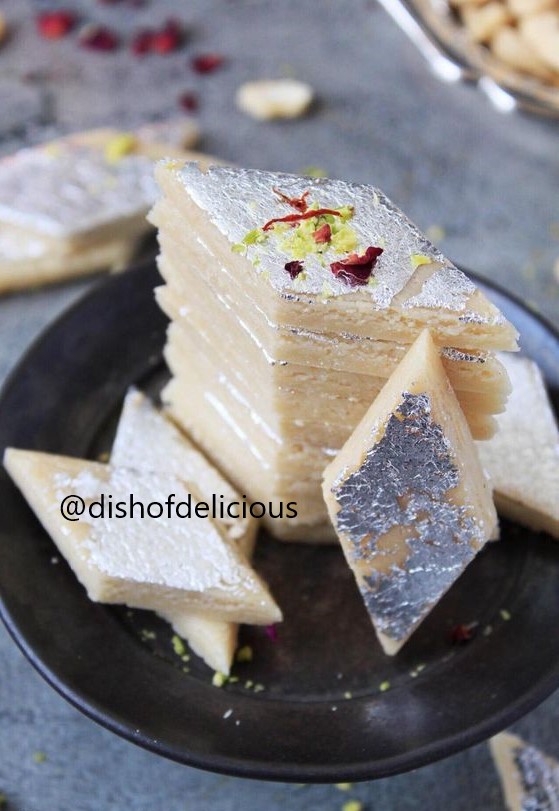Introduction:
- Kaju Katli, also known as Kaju Barfi, is a mouthwatering Indian sweet that’s loved by people of all ages. It’s a famous dessert that’s often prepared during festivals, special occasions, and family gatherings. The name “Kaju Katli” literally translates to “cashew slice,” and that’s exactly what this sweet treat is – a delightful slice of cashew goodness. In this blog, we’ll guide you through the Kaju Katli recipe step by step, offering tips, variants, and consultations to help you create this delectable Indian sweet at home.
Kaju Katli: A Sweet Slice of India:
Kaju Katli, also known as Kaju Barfi, is a beloved and iconic Indian sweet that has captured the hearts and taste buds of people both within India and around the world. This delectable treat holds a special place in Indian culture and is an integral part of celebrations, festivals, and family gatherings.
The Essence of Kaju Katli:
At its core, Kaju Katli is a simple yet sophisticated sweet made primarily from two key ingredients: cashew nuts and sugar. The name itself offers a clue to its primary components, with “Kaju” representing cashew and “Katli” referring to slices. To prepare Kaju Katli, cashew nuts are ground into a fine powder, and this nutty goodness is then blended with a sugar syrup infused with aromatic cardamom. The resulting mixture is carefully cooked, cooled, and cut into diamond-shaped or square pieces. The final product is a melt-in-your-mouth confectionery that boasts a delicate, nutty flavor and a subtle hint of cardamom.
Kaju Katli Recipe:
Ingredients:
- 1 cup cashew nuts
- 1/2 cup sugar
- 1/4 cup water
- 1/4 teaspoon cardamom powder
- 1 tablespoon ghee (clarified butter)
Instructions:
- Grind Cashews: Begin by grinding the cashew nuts into a fine powder. Make sure not to over-grind, as this can release the natural oils from the nuts, turning them into a paste.
- Prepare Sugar Syrup: In a separate saucepan, add sugar and water. Heat it over low-medium heat while stirring continuously until the sugar dissolves completely. You can check the sugar syrup consistency by dropping a small amount into cold water. It should form a soft ball. This is known as a one-string consistency.
- Combine Cashew Powder: Once the sugar syrup reaches the one-string consistency, add the cashew powder and cardamom powder to it. Stir well to ensure there are no lumps.
- Cook the Mixture: Continue to cook the mixture on low heat, stirring constantly to avoid sticking or burning. It will thicken and leave the sides of the pan.
- Add Ghee: Now, add the ghee and mix it well with the cashew mixture. This will give your Kaju Katli a rich flavor and smooth texture.
- Shape the Katli: Remove the mixture from the heat and transfer it to a greased plate or tray. Allow it to cool slightly, so it’s safe to handle. Grease your hands with a little ghee and flatten the mixture into a thin, even layer.
- Cut into Diamonds: While it’s still warm, use a knife to cut the cashew mixture into diamond or square-shaped pieces.
- Let it Cool: Allow the Kaju Katli to cool completely. Once cooled, gently remove the pieces from the plate.
Tips for Perfect Kaju Katli:
- Use fresh cashews for the best flavor and texture.
- Keep the heat low while cooking to prevent the mixture from burning.
- Stir continuously to avoid lumps and ensure even cooking.
- Grease your hands and utensils with ghee to prevent sticking.
- Store Kaju Katli in an airtight container to keep it fresh for longer.
Variants:
While the classic Kaju Katli recipe is beloved, there are some fun variations you can explore:
- Chocolate Kaju Katli: Add cocoa powder to the cashew mixture for a delightful chocolate twist.
- Pista Kaju Katli: Mix finely ground pistachios with cashew powder for a colorful and nutty variation.
- Rose Kaju Katli: Infuse the sugar syrup with a few drops of rose essence for a fragrant twist.
Frequency Asked Questions (FAQ):
Q1: What does “Kaju Katli” mean?
A1: The name “Kaju Katli” is a combination of two words: “Kaju,” which means cashew, and “Katli,” which means slices. It essentially translates to “Cashew Slices.”
Q2: What is the one-string consistency for sugar syrup?
A2: One-string consistency is a term used in Indian cooking to describe the stage at which the sugar syrup is ready for use in sweets like Kaju Katli. To test it, take a small amount of syrup between your thumb and forefinger, and when you separate them, a single string of syrup should form.
Q3: Are there any variations of Kaju Katli?
Q3: Yes, there are several variations of Kaju Katli. Some popular ones include Chocolate Kaju Katli, Pista Kaju Katli (with pistachios), and Saffron Kaju Katli. These variants add unique flavors and colors to the traditional recipe.
Q4: How long does Kaju Katli stay fresh?
Q4: Properly stored in an airtight container at room temperature, Kaju Katli can stay fresh for up to two weeks. You can refrigerate it for a longer shelf life, but make sure it’s in an airtight container to prevent it from absorbing any odors.
Q5: Can I freeze Kaju Katli?
Q5: Yes, you can freeze Kaju Katli for an extended period. Place individual pieces in an airtight container or wrap them in plastic wrap and then aluminum foil before freezing. When you’re ready to enjoy them, allow them to thaw at room temperature for a few hours.
Q6: Can I find Kaju Katli outside of India?
Q6: Yes, Kaju Katli is available in Indian sweet shops worldwide, and it’s also a favorite at Indian restaurants. You can even make it at home to enjoy its authentic flavor no matter where you are.
Consultation:
- If you ever face any difficulties while making Kaju Katli or have questions about the recipe, don’t hesitate to reach out to us in the comments section below. We’re here to help you create this famous Indian sweet to perfection.
- In conclusion, Kaju Katli is not just a delicious dish but also a symbol of love and celebration in Indian culture. With this easy-to-follow recipe and our helpful tips, you can now make this sweet treat at home and savor its rich, nutty flavor. Enjoy making and sharing Kaju Katli with your loved ones for a taste of India’s culinary heritage. Happy cooking!



